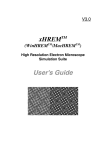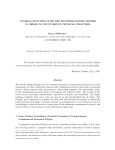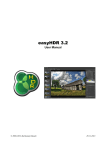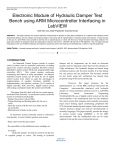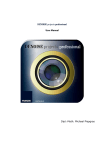Download HDR_Projects_Photo_Handbuch_Translation DE into EN.indd
Transcript
USER MANUAL HDR projects photo Table of contents 1. HDR projects – Quick guide.............................................................................4 Importing images....................................................................................................................................... 4 Setting up the HDR parameter.............................................................................................................. 6 Tone mapping and Post-processing.................................................................................................... 7 Saving the final image.............................................................................................................................. 8 2. Program & interface............................................................................................9 2.1 Interface................................................................................................................................................10 2.1.1 The File menu..................................................................................................................................10 2.1.1.1 The Projects submenu..............................................................................................................11 2.1.2 The Edit menu.................................................................................................................................11 2.1.3 The View menu...............................................................................................................................11 2.1.4 The Settings window....................................................................................................................13 2.1.5 The Information menu.................................................................................................................15 2.2 Drag & Drop.........................................................................................................................................15 2.3 Toolbars.................................................................................................................................................16 2.3.1 Main toolbar....................................................................................................................................16 2.3.2 Image area toolbar........................................................................................................................17 2.4 Image area...........................................................................................................................................19 2.5 Progress bar.........................................................................................................................................20 2.6 Modifying the interface..................................................................................................................20 3. HDR creation....................................................................................................... 21 3.1 HDR preparation................................................................................................................................21 3.1.1 Colour space conversion.............................................................................................................22 3.1.2 White balance..................................................................................................................................22 3.1.3 Colour noise suppression...........................................................................................................22 3.1.4 Automatic alignment...................................................................................................................22 3.1.4.1 Shift and automatic cropping................................................................................................23 3.1.4.2 Turns, shearings, movement..................................................................................................23 2 3.1.4.3 Genetic algorithms....................................................................................................................24 3.1.5 Automatic ghosting correction................................................................................................25 3.2 The work area exposure bracketing...........................................................................................25 3.2.1 Synthetic exposure bracketing images.................................................................................27 3.2.2 Global weight & Exposure value..............................................................................................28 3.3 The work area of HDR algorithms................................................................................................29 3.3.1 An overview of HDR algorithms...............................................................................................30 3.3.2 Parameters of HDR algorithms..................................................................................................30 4. Tone mapping / post-processing................................................................. 32 4.1 Default settings..................................................................................................................................33 4.2 Tone mapping expert mode..........................................................................................................34 4.2.1 Tone mapping algorithms..........................................................................................................35 4.2.2 Post-processing filters..................................................................................................................35 4.2.3 Selected effects..............................................................................................................................37 4.2.3.1 Parametrisation...........................................................................................................................38 5. Batch processing............................................................................................... 40 5.1 Source file.............................................................................................................................................41 5.1.1 Allocation/Automatic exposure bracketing detection....................................................41 5.2 Results...................................................................................................................................................42 5.2.1 Format................................................................................................................................................42 5.2.1.1 Batch processing with re-sort mode...................................................................................43 5.3 Processing settings...........................................................................................................................43 5.4 Exposure bracketing preview.......................................................................................................44 5.4.1 Allocated exposure bracketings...............................................................................................44 5.5 Progress bar.........................................................................................................................................46 5.6 Direct Start button............................................................................................................................46 5.7 Preview during processing............................................................................................................46 3 HDR projects photo Quick guide 1. HDR projects – Quick guide In order to quickly achieve good results the following four basic steps are all that you need to know: ❶ Importing images ❷ Setting up the HDR parameter ❸ Tone mapping post-processing ❹ Saving the final image If you want to learn more about the possible settings of HDR projects, please skip to chapter 2. There you will also find some tips & tricks that will help you to improve your final image. ❶ Importing images Here you have the following editing steps for the HDR preparation: In order to import a single image (HDR from a single image), an exposure bracketing (multiple images) or a project file (.hdrproject), simply drag and drop them into the program window. You can alternatively use the toolbar or the file menu. As soon as you have chosen a single image or an exposure bracketing the HDR preparation window will pop up. • • • • • choose a colour space white balance the degree of colour noise suppression automatic alignment of the image automatic ghosting correction You can find a detailed description of these steps in chapter 3 or in the information section within HDR projects. In most cases the default settings are sufficient to achieve good results. As soon as you confirm the settings by clicking on the arrow Apply settings the importing process and the preparation of the image with your chosen settings will start. After import and preparation of the image is complete you will see the dialogue for the HDR parameters. 4 5 HDR projects photo Quick guide ❷ Setting up the HDR parameter ❸ Tone mapping and Post-processing The screen will now be divided into different areas: ❶ Exposure bracketing ❷ Toolbar ❸ HDR preview ❹ HDR algorithms ❺ Information on the currently selected area ❷ ❶ ❸ This screen is divided into the following areas: ❹ ❶ Default settings ❷ Toolbar ❸ Tone mapping preview ❹ Tone mapping and Post-processing effects ❺ Information on the currently selected area ❷ ❶ ❸ ❺ ❹ ❺ You can now edit single images from the exposure bracketing section (on the left), for example, by changing the exposure, excluding an image from the HDR creation or editing the global weight a single picture has to the final result. The special characteristic of synthetic exposure bracketing in HDR projects is explained in detail in chapter 3.2.1. With the HDR algorithms (on the right) you can fine-tune the creation of the HDR image to your motif. For this purpose you have eleven HDR algorithms at your disposal which all have different parameters (see chapter 3.3.1.). When you have chosen the desired setup for the HDR area, click on the palette symbol in the toolbar to proceed to the tone mapping and post-processing. Select one of the default settings on the left (Preset) that fits to the motif on your image (Landscape in our example). The default settings included in HDR projects are now displayed and you can choose one by left-clicking on it (powerful colours in our example). You can see all the effects used in this default setting in the expert mode bar on the right where all the selected filters are displayed. You can configure the list of effects as you wish by adding, removing or re-sorting effects. If you want to adjust an effect‘s parameters, click on the effect. The parameters are now displayed underneath the lists of effects. 6 7 HDR projects photo Program & interface ❹ Saving the final image 2. Program & interface You can now save the final image by left-clicking on the disk symbol (Save final image) in the upper toolbar. Choose a file path and a format (.tif, .tiff, .jpg, .exr or .hdr) for the final image and enter a file name. If you have performed all of these steps without coming across the software‘s preview mode, the following question will be displayed: HDR projects is available in three different versions: Mac OS – 64-bit, Windows – 32-bit, Windows – 64-bit. Generally there are no restrictions towards importable picture sizes, but with the 32-bit version for Windows you will experience a limited maximum size of 22 megapixels per single image in an exposure bracketing. This is due to the operating system‘s limitations. Exposure bracketings can consist of up to 9 single images. All known camera raw image file formats and almost all image formats are supported by the software: Confirm by clicking Yes in order to calculate your image in its highest resolution and to save it. Congratulations! You have just created your first impressive HDR image with HDR projects! 8 9 HDR projects photo Program & interface All calculation areas support multithreading with up to 32 CPU cores. In addition, HDR projects uses the full capacity of your graphics card which makes it an effective tool for the creation of HDR images. 2.1 Interface HDR projects uses an interface that follows the modern guidelines of an ergonomic user guide and contains detailed tooltips for every button. In order to trigger an operation simply left-click on the corresponding button. Many buttons have context menus that you can access by right-clicking on the button. Of course you can access many essential functions with hotkeys. For example, simply press in order to switch to the HDR area and press to go to the tone mapping dialogue. 2.1.1 The File menu With the File menu you can open and save HDR images and projects. The menu is subdivided into: Start: With Start you can go back to an empty work screen (like the one that appears when you start the software). You will be asked if you want to save the current project before it gets deleted from the software‘s memory. Importing images: With HDR from a single image you can import a single image. By selecting Import exposure bracketing you can import more than one image of a single bracketing. The option Exposure bracketing browser... performs an automatic search for images that belong to the same bracketing. Save final image: Here you can save the current image as your final image any time. Projects: This option takes you to a submenu that will be explained in detail in the following chapter. 10 2.1.1.1 The Projects submenu The Projects submenu is a special feature of HDR projects. With this feature you can create project files (.hdrproject) that let you save all the changes that you have performed in one exposure bracketing at any time. With this option you can open (Open project), overwrite (Save project) and save projects under a different name (Save project as...). Note: Projects take up a significant amount of space on your hard drive; nevertheless they allow you to quickly load and continue an unfinished project. 2.2.2 The Edit menu With the Edit menu you can switch between three different modes: Edit exposure bracketing and Tone mapping/post-processing . 2.2.3 The View menu With the View menu you can add or remove additional windows, change the frame colour for the image area and reset your configuration of the interface to the default settings. Information windows ( c ): In this window you can find context sensitive information about your current work area at any time. Exif information window ( c E ): The EXIF information for the currently selected image of the exposure bracketing will be displayed. If no image has been selected, the EXIF information for the master image (the centre image) will be displayed. HDR histogram ( c H ): In the HDR histogram you can individually activate or deactivate the distribution of luminance and the colours red, green and blue. 11 HDR projects photo Program & interface The option cumulative allows you to display a summarised histogram. This may be helpful when you are trying to take a closer look at the brightness control within an image. 2.1.4 The Settings window ❶ ❷ Note: By left-clicking on the histogram you can transfer it to the image area, and watch and analyse it in a higher resolution. Interface style: Here you can choose from four variants of the whole interface—purple, dark gold, dark grey (default setting) and light grey. Frame colour: You can choose from two modes for the frame colour which will be displayed around your image. Grey card: The grey card is the classic grey value of photography with a fixed brightness value of 18%. Automatic (ambient colour frame): The automatic frame colour mode is a special feature of HDR projects. It automatically calculates in real time and displays the optimum frame colour based on your current final image. Restore window defaults: With this option you can reset the interface configuration to the default settings. 12 ❹ ❻ ❸ ❺ ❶ Program location Here you can set the standard locations for importing and exporting data: Projects: The default path for project files (.hdrproject) Exposure bracketing: The default path for exposure bracketing files Single images: The default path for single images (HDR from a single image) Final images: The default path for your final images You don‘t have to set these default paths, but if you do it will simplify the loading/saving of your images. 13 HDR projects photo Program & interface ❷ External Programs HDR projects can send final images directly to other applications. Here you can enter the file (.exe) of the application that you would like to export final images to. ❸ Gamma conversion Here you can set the gamma value for the development of images for all floating point file formats, which are HDR images in the formats .hdr and .exr. ❹ Language 2.1.5 The Information menu In the Information menu you can directly access the HDR projects homepage which will be loaded onto your standard web browser. The option Help will open via the external PDF viewer used on your system. By clicking on Go to updates page you will directly enable HDR projects‘ update service where you can download a new/updated version of HDR projects. Further information on HDR projects including the current version, the credits and the external licences, can be found under the menu About HDR projects. 2.2 Drag & Drop Here you can set the interface language to German or French. You need to restart HDR projects for the language change to take effect. ❺ Preview mode HDR projects‘ extensive Drag&Drop support enables you to drag files to the software interface and just drop them by releasing the mouse button. Drag & Drop is context sensitive and can decide automatically which function to use depending on the imported file. All calculations in preview mode are performed with a reduced image size in order to speed up the processing. You can select a resolution in megapixels on the right or you can choose one of the two default settings: optimal or quick. The former fits the size of the preview to the display area while the latter uses half of the display area and is primarily used for the real-time animation mode in the post-processing module. ❻ Restore settings to standard values Left-clicking this button will reset all options in this window to the default settings. If you drag and drop three image files from one exposure bracketing, as in our example, HDR projects will automatically start the image bracketing view. 14 15 HDR projects photo Program & interface 2.3 Toolbars image that has been treated with tone mapping will be saved. HDR projects has two toolbars that show the available options depending on the context. Options that you cannot use will consequently be omitted for clarity. 2.3.1 Main toolbar After starting the software you can find the main toolbar at the top left of the screen, but you can drag it to another location if you like. If you have imported an exposure bracketing, the toolbar looks as follows: ❶ ❷ ❶ Start ❸ ❹ ❺ ❻ ❼ ❽ Closes the current project after asking if you would like to save it and returns you to an empty start page. ❷ Save project Saves the project under the current name. If you have not given a name to the current project, the function Save project as... will be used instead. ❸ Editing modes The button with the three images and the wheel lets you switch between HDR- and Edit exposure bracketing at any time. Detailed information on this mode can be found in chapter 5. Clicking on the colour palette button will start the tone mapping and post-processing mode. ❹ Save final image This button opens the window where you can save the current image. If you are currently in the HDR area, the HDR image will be saved. If you are in tone mapping/post-processing mode, the 16 ❺ Open final image in external program Starts the external software stated in the program settings and uploads the current final image into this software. ❻ Create restore point With this you can create a restore point for the current state of your work before you make significant changes to the settings/ calculation values. ❼ Revert to restore point ❽ Information windows With these three buttons you can open the program information window, the window for the EXIF data and the histogram window. 2.3.2 Image area toolbar ❶ ❷ ❸ ❹ ❺ ❻ ❼ ❽ ❶ Preview mode (here shown as on) In preview mode your image will be downsized to 1 megapixel, and all calculations are performed with this smaller image size in order to enable you to work in real time without any waiting times no matter how large your original image is. ❷ Real-time calculation mode (here shown as on) If real-time calculation mode is activated, all the changes you make will be immediately calculated into a new final image. If this mode is not active and you make changes to your image, the button re-calculate will be available. ❸ Re-calculate This button triggers the calculation of a new final image with the current settings. 17 HDR projects photo Program & interface ❹ Show border pixels The button show border pixels is only available during Tone mapping/post-processing. Yellow or red pixels indicate brighter areas while blue and violet pixels indicate darker areas. Note that further editing of these two areas might cause a loss of detail in the image. ❺ Original resolution view 2.4 Image area The image area is the centre area in HDR projects and has an additional status bar. To zoom in and out on the image simply use your mouse wheel or the multi-touch mouse of your Macintosh. Use the button Original resolution view to set the zoom factor to 100%. One pixel on screen will then be equivalent to one pixel in the final image. ❻ Zoom control With the zoom control you can smoothly regulate the zoom factor between 10% and 1000% in real time. As interpolation would work exactly on the scale of single pixel areas this feature was not included here. ❼ Monitor size With this button you can set the zoom to monitor size and display the whole image at as high a zoom as possible. ❽ Additional functions This button opens a section of the toolbar with the additional functions Horizontal mirroring, Vertical mirroring, 90 degree rotation (anti-clockwise), 90 degree rotation (clockwise). 18 To change the displayed area of an image simply click in the image, hold down the mouse button and drag your cursor over the image. If you have zoomed in, this will open a small window with an overview of your image that will help you to keep track of where you are inside your motif. The status bar on the bottom part of the screen shows you some basic data on the motif, such as the resolution, the number of megapixels, the ISO value of your images, the current cursor position and the pixel colour at the current cursor position. 19 HDR projects photo HDR creation 3. HDR creation 2.5 Progress bar The progess bar shows you what is currently being calculated and the progress of the calculation. If an error occurs during calculation, the info part of the progress bar will display the various steps of the calculation with different colours: • • • green: This step has been successfully completed. yellow: This step resulted in a warning. HDR creation is the basis for a good final image from an exposure bracketing or for the function HDR from single image. HDR projects uses the following basic steps for this: • • • HDR preparation (chapter 3.1) Optimising the exposure bracketing (chapter 3.2) Choosing an appropriate HDR algorithm (chapter 3.3) The possibility to optimise the exposure bracketing and the ability to choose and change the parameters for different HDR algorithms are probably new to you since these methods have never been used in comparable softwares before. red: This step caused an issue. 3.1 HDR preparation 2.6 Modifying the interface You can modify the HDR projects interface according to your preferences. This means that you can drag any work area, toolbar or information window to any given place on the screen or even on a second screen. In order to unlock an area from the interface (disconnecting), double-click on the respective title bar or just drag the area out of the interface by holding down the mouse button while pointing at the title bar. You can attach the window back to the main interface in the same way. Double-clicking on the title bar will move the area back to its original position in the main interface. You can also move the area to a new position within the interface if you prefer. 20 At HDR preparation you can set the steps for the transformation of your imported images. These steps will be calculated after the loading process. The transformation steps in detail are: • • • • • Colour space conversion White balance Colour noise suppression Automatic alignment Automatic ghosting correction Click on the arrow (Apply settings) on the bottom right of the screen to apply those settings. 21 HDR projects photo HDR creation 3.1.1 Colour space conversion 3.1.4.1Shift and automatic cropping HDR projects lets you choose from nine colour spaces, especially for camera raw images. The default setting is the Adobe RGB colour space, which was defined by Adobe Systems in 1998. Many programs like Photoshop or Lightroom use this colour space. If you are not sure which colour space to use, just use the Adobe RGB colour space or alternatively the standard RGB colour space. The most common error in exposure bracketings is the "camera shake". Note: Automatic alignment of your exposure bracketing requires a lot of calculation time during import. If you are sure that your exposure bracketing is not blurred, you can deactivate this option in order to improve upload times. Automatic cropping is part of the alignment when it comes to moving images. This option erases empty areas at the edges of your images that usually appear when you have to shift/align an exposure bracketing. 3.1.2 White balance With White balance you can correct colour fog, which can be caused by taking a photograph in special environments, such as in a room with coloured lighting or outside during the "blue hour" (twilight). The balance colour is given as colour temperature in Kelvin, usually between 1000 K and16500 K. Choose your preferred balance from the default settings or use the colour temperature control underneath the default settings. 3.1.3 Colour noise suppression HDR projects provides you with the options to Denoise darker images more strongly: When you take an exposure bracketing the images taken with less exposure time (the darker pictures) have a higher colour noise than the brighter ones. If this is the case for your motif, choose to denoise the darker images more. 3.1.4 Automatic alignment You can use the automatic image alignment to correct shifts, turns, shearings and movement that happened when you were taking an exposure bracketing. These image faults are often caused by taking exposure bracketings unaided. 22 3.1.4.2 Turns, shearings, movement Another variant of a fault in an exposure bracketing is the "twisting" of the camera while taking a photograph or moving objects. For the latter you have to figure out if the error is due to a ghost image or if it is a flaw that can be corrected with an image alignment. As a rule of thumb see the following: occurs if you have an object that moves within itself, such • Aasflaw a flame or objects that move with the wind. images are objects that move a certain distance within • Ghost the time it takes to take one exposure bracketing, for example a person or a vehicle. Let‘s come to one of the great obstacles in automatic image alignment: the moving flame of a candle in an exposure bracketing containing 10 images. On the right you can see the candle flame that has been aligned with HDR projects. Compare with the unaligned original on the left. 23 HDR projects photo HDR creation The result is already pretty good, but it can be made even better with genetic algorithms that are further explained in the following chapters. On the left you can see the exposure bracketing with standard alignment measures being used. On the right you can see the same exposure bracketing after genetic algorithms have been applied— the result is a very still and calm flame. 3.1.5 Automatic ghosting correction 3.1.4.3 Genetic algorithms Genetic algorithms are a specially developed iterative method to optimise the alignment of exposure bracketings. HDR projects is the first software to use this method. The genetic algorithm can be added to other alignment measures, which means that in order for the genetic algorithms to have an effect you must activate one of the basic methods first. Let‘s have another look at the candle flame: With the automatic ghosting correction you can treat moving objects within an exposure bracketing when these objects have travelled a certain distance within the bracketing. On the left you can see a typical situation that leads to ghost images: an exposure bracketing containing three images that shows a busy street. The cars in the lower third of the image were moving while the bracketing was being taken. Therefore, you can see a row of semitransparent vehicles. On the right you can see the corrected version: the ghost images of the vehicles have disappeared. 3.2 The work area exposure bracketing As soon as you have uploaded an exposure bracketing in HDR projects you will see the HDR creation area which consists of the work areas for exposure bracketings on the left of the screen and the HDR algorithms on the right. You can see your HDR image in the centre of the screen. 24 25 HDR projects photo HDR creation The weight matrix helps you to determine how strongly the HDR result will be influenced by a certain area of an image from the exposure bracketing. By clicking on the minus button below the weighting colour the corresponding image will be deleted from the exposure bracketing. 3.2.1 Synthetic exposure bracketing images With the uppermost check box you can exclude an image from the exposure bracketing or include it again. Underneath you can find the miniature view of the exposure bracketing image. If you want to see it in full size, simply left-click on it. Leftclick again if you want to switch the view back to the final HDR image. On the right of the colour view you can see the weight matrix for the exposure bracketing. This greyscale image can be interpreted as follows: • • Bright pixels indicate that this area will have a heavy influence on the final HDR image. Dark pixels indicate that this area will have a lesser influence on the final HDR image. 26 Synthetic exposure bracketing images are a special feature of HDR projects. You can use these images in order to fill up gaps in the exposure bracketing. This method can be used, among other things, to create HDR from a single image. Whenever you upload a single image two synthetic images will be automatically added, with one of them having a shorter exposure and the other having a longer exposure. When you upload a bracketing with two images one additional synthetic image will be added. This way you will always have at least three images in every exposure bracketing at your disposal. With the button synthetic you can transform a real image into a synthetic one. At the bottom of the work area exposure bracketing you can find the a button called add synthetic image. With this button you can add another synthetic image to your bracketing. The image with the designation "Master image" will always be used as your output image. Note: Synthetic images can also be used to edit certain exposure areas in a motif. 27 HDR projects photo HDR creation 3.2.2 Global weight & Exposure value Every exposure bracketing image has two control panels, irrespective of whether it is an original image or a synthetic one. With these two control panels—global weight and exposure value (EV)—you can influence the outcome of the HDR creation enormously. The example on the left shows an exposure bracketing directly after uploading it. The control panels for global weight and for exposure value are both set to the middle. The example in the middle shows the first bracketed image (DSC03641.jpg) with a higher global value. This image now has a stronger influence on your final HDR image which is indicated by the brighter look of the global weight view. Your final HDR image will be a little bit darker as a result because the image with the shorter exposure has a stronger influence during the HDR fusion. The example on the right shows a higher exposure for the image in the middle, which is also the master image (DSC03642.jpg). This influences the final HDR image twofold: this bracketed image is now brighter which means that you are changing the uploaded exposure bracketing in the memory. Furthermore, the weight of the image per pixel changes because it is now a modified exposure bracketing image. Above the actual exposure bracketing you can find default settings for global weight. With these default settings you can choose from seven algorithms for an automatic setup of the global weight: • • • • Equal: sets all global weight control panels to the middle position. Every image from the exposure bracketing will be treated equally. Luminance: sets all global weight control panels to a value that corresponds to the average brightness (luminance) of the bracketed image. Congruence: sets all global weight control panels to a value that corresponds to the average congruence of the bracketed image in comparison to the master image. Luminance/congruence: sets all global weight control panels to a value that corresponds to the average brightness of a bracketed image in relation to the average congruence towards the master image. Note: If you choose the default setting congruence this may result in a slight improvement of ghost images in some exposure bracketings. 3.3 The work area of HDR algorithms You can find the HDR algorithms together with the parameter controls on the right of the interface. An HDR algorithm is a mathematical code that determines the weight (see the weight view in the exposure bracketing) of the single bracketed images per pixel. Every algorithm affects the final HDR image in a different way and has, depending on the motif, its strengths and weaknesses. 28 29 HDR projects photo HDR creation 3.3.1 An overview of HDR algorithms • • • • • Average: The average is the simplest form of HDR creation and creates an average from all of the exposure bracketed images. Entropy: Entropy in information theory is a degree of measurement for information density. If you use this for HDR creation, you have an algorithm that measures the information density of the exposure bracketing images per pixel and calculates from those the weight for the HDR creation. This is a very stable method which is also set as the default algorithm for HDR projects. Smoothing: Smoothing influences the weighting matrixes that emerge from the HDR algorithms. It indicates the smoothing of images depending on image resolution in a percentage. A value of 50% means that the weight matrixes will be smoothed over with an expansion of 50% of the resolution using a Gaussian blur. Luminance distance: Luminance distance uses the average brightness distances in an image as a method of weighting an image for HDR creation. This method is also universally useful, so it can be applied to almost any exposure bracketing. Colourmix: The colourmix method uses the colouring of the pixels as a unit for measuring the weight of an image. It is especially useful for bracketings that only have a slight brightness difference in certain areas of the images, such as images containing fog, smoke or clouds. Luminance entropy: Luminance entropy is a combined method using both luminance distance and entropy. 3.3.2 Parameters of HDR algorithms Underneath the list of HDR algorithms you can see up to four control bars for fine-tuning the parameters. • • Denoising: Denoising directly affects the HDR image and indicates its strength in a percentage. A value of 0% leads to no pixels with noise being deleted; while a high value will denoise the HDR image strongly. The latter automatically leads to an image with less sharpness. 30 If you take a look at the windows in this example, you may notice that the "content" of the windows will be displayed better with a harder smoothing (upper picture). HDR smoothing is a very strong tool that you can use to optimise your HDR images. Unfortunately, finding the best smoothing value cannot be performed automatically using mathematics because it depends heavily on the user‘s individual taste. Note: A smoothing value of 0% (no smoothing at all) is only viable for the algorithms Entropy and Luminance distance. The algorithms further down are only suitable for HDR creation without smoothing in a few special cases. 31 HDR projects photo • Tone mapping / post-processing Night/daytime: With this option you can adjust the HDR algorithm to an image taken at night or during the day. Due to mathematical reasons this option cannot be used for the Average algorithm. adjustment: This option deals with a typical problem of HDR • Halo creation: you can see visible halos appear at the transition to the sky. The image on the right has a halo adjustment of 85% which lets all halo effects disappear. Due to mathematical reasons this option cannot be used for the Average and Entropy algorithms. 4.1 Default settings With the default settings you can achieve a nice result with a single click of the mouse. The default settings are separated into eight categories, six of them being theme based from Landscape to Artistic, plus the two options Custom and All. After you have decided which category to use choose one of the default settings by simply clicking on the corresponding preview image. These previews are miniatures of the HDR image and are being calculated in real time, which means that you get a first impression of the effect from the tone mapping on the final picture while you are browsing through them. Natural standard: Very natural image without too many effects. Only an expert can see at first glance that this is an HRD image. 4. Tone mapping / post-processing After having created and adjusted your HDR image, the next step is the tone mapping that you saw during HDR preparation (local tonal value compression), combined with the post-processing of the image. HDR projects offers you different algorithms in the tone mapping section and a variety of post-processing effects including different default settings. 32 Natural highlight details: This image resembles a painting by applying local dodging and sharpening. 33 HDR projects photo Tone mapping / post-processing Additionally to the theme-based default settings there are two more categories: Custom and All. Your custom-made default settings will be saved under Custom while All will let you combine all available default settings. The default settings have diverging functions that you can find on the right of the respective preview image. 4.2 Tone mapping expert mode You can find the expert mode panel for tone mapping and post-processing on the right of the screen. With this you can configure the whole image editing, test new effect combinations or edit default settings according to your wishes. There are four different lists in this panel: ❶ Tone mapping algorithms ❷ Post-processing filters ❸ Effects you have selected ❹ Parameters of your selected effects Tone mapping algorithms and post-processing filters are filters that you can opt for, and the selected filters are those which are represented in the current calculation. The way these filters work and how to transfer the filters into the list of selected filters will be explained in the following chapters. 34 4.2.1 Tone mapping algorithms Tone mapping algorithms are purely there for enhancing the quality of the image. HDR projects lets you choose from different algorithms that can each be used on its own or combined. In order to add a tone mapping to your list of selected filters simply double-click on it. Alternatively, you can right-click on it to open a context menu. ❷ Gradient tone mapping: This is a method with strong effects that is suitable for motifs with weak colours and high contrasts. Average tone mapping: This is a very stable method and can be used for almost any motif. Sigmoid tone mapping: Sigmoid tone mapping is a very special method that has been optimised for motifs with strong highlighted areas. ❸ 4.2.2 Post-processing filters ❶ ❹ This list contains 52 different filters for post-processing. They are subdivided into six categories. Depending on the category the filters are highlighted with a different colour: • • • • • • Yellow: Edge effects Green: Geometry effects Cyan: Exposure effects Blue: Colour effects Violet: Scrim diffuser effects Pink: Artistic effects 35 HDR projects photo Tone mapping / post-processing In this list you can find all the classic post-processing effects of the HDR area, such as: • • • • • • Detail strengthener Denoise and sharpness filter Gradation curves Greyscale conversion Rotation and zoom Lights and shadows • • • Correction of chromatic aberrations Colour adaptation by tone, brightness, balance, temperature Blurring You can add an effect by double-clicking on it or via the context menu (right-click): Add effect: Adds the effect to the list of filters. Show all effect groups: Shows all six effect groups. Now you can see all the available effects. All effect groups off: Hides all of the six effect groups. Filter enhancers on/off: (De-)Activates filter enhancers. Geometry effects on/off: (De-)Activates geometry effects. Exposure effects on/off: (De-)Activates exposure effects. Colour effects on/off: (De-)Activates colour effects. Blurring effects on/off: (De-)Activates blurring effects. Artistic effects on/off: (De-)Activates artistic effects. Display panorama effects only: Shows only panorama effects. 36 4.2.3 Selected effects The list of the effects that you have selected is the core of the tone mapping and post-processing area. Here you can manage all of the postprocessing and the parameters for every single effect. In our example we have an effect chain of three different filters: Average exponent tone mapping, median noise suppression and automatic black/white point. These three filters will be automatically applied to the HDR image one after the other and will result in a final tone mapping image. In order to temporarily deactivate an effect simply click on the check box in front of the effect name. Double-clicking on an effect will remove it from the list. In the list of effects you have selected you also have a context menu with numerous options. In order to rearrange the order in which the effects appear in the list you can simply drag & drop them within the list. Note: The sequence in which the effects appear in the list can have a major influence on the resulting image. 37 HDR projects photo Tone mapping / post-processing The image on the left has significantly less detail inside the archway. If you use the Brightness-Contrast-Gamma effect first on the image, you will darken the areas that are already dark and cause brightness breaks—the following tone mapping cannot compensate for this. Compare with the image on the right where a tone mapping has been conducted beforehand. The details in the archway are a lot more visible. 4.2.3.1 Parametrisation You can change the parameters of single effects in the panel below the list of your selected effects. The parameters of your currently selected effect will be displayed here. There are different types of parameters: Sliders, Splines, Colours & Pipette, Positions and Lines. Some effects may have up to eight parameters. Sliders: Sliders are the simplest form of parametrisation. Simply move the slider in order to change the value that influences the effect to the left (smaller value) or to the right (bigger value). Alternatively, you can enter your desired value directly via the number field above the slider. In our example you can see the parameters for the effect Colour balance which consists of three sliders for the balancing. Splines: The curve parameters are divided into two types: gradation curves that have a direct effect on the images‘ brightness, and mask curves that define the intensity of an effect on the different brightness areas within the image. Both types of curves can be modified the same way. Every curve (Spline) has six control points. These points (with the exception of the outermost points) can be dragged horizontally and vertically within the frame. 38 Gradation curve: In our example you can see a gradation curve that directly affects the brightness. The diagonal line is the standard status of the curve because it creates the original image. If you drag one of the points to the bottom, the pixels with the corresponding brightness will become darker and vice versa. In addition, you can find a box with default settings for the curve on the top right. In our example we have used the default setting overexposed. In the background you can see a preview of what the gradation curve will do displayed in greyscale (representing the different brightnesses). This preview is calculated in real time as you move a control point. Mask curve: In our example you can see a mask curve. This curve influences the intensity of an effect (here Colour intensity) on the different brightness areas in the image. If you drag one of the points towards the bottom, the pixels of the corresponding brightness will be less affected by this effect and vice versa. You can find a box with default settings on the top right as well. In our example we have chosen the default setting Shadows. For the colour intensity in our example this means that an increase of 150% will be calculated completely for very dark pixels, and pixels with about 30% brightness will only be affected by half and so on. The preview in the mask curve shows the effect‘s intensity from black (no effect) to white (full effect) in real time while you modify the curve. 39 HDR projects photo Batch processing 5. Batch processing 5.1 Source file HDR projects‘ Batch processing allows you to automatically process multiple exposure bracketings. You can access this feature via the Extras menu or using the shortcut c . The Batch processing window is subdivided into the following areas: ❶ Source file ❷ Results ❸ Processing settings ❹ Exposure bracketing ❺ Progress bar ❶ ❸ ❹ ❷ Start by selecting a source directory containing the single images (HDR from a single image) and/or the exposure bracketing. These files can also be mixed—the automatic exposure bracketing detection will sort them for you. With the include all subdirectories option you can not only search through the selected folder for images but also through all the subfolders and their respective subfolders. This is called "recursive file search". Note: Please take into account that searching through a folder with many subfolders might take some time. Therefore it is best not to select "C:\" as the folder that you want to start searching through. 5.1.1 Allocation/Automatic exposure bracketing detection The allocation and automatic exposure bracketing detection takes care of sorting through images for you. You can choose from several modes: Automatic allocation: The automatic allocation uploads all images and finds those images that belong to an exposure bracketing. In this process the luminance and image congruence are taken into account which ensures a very accurate automatic detection. As you can see in our example below HDR projects has correctly identified and allocated the 20 exposure bracketings that have been uploaded. Note: The separate elements of the exposure bracketing area will be explained in detail in chapter 6.4. ❺ 40 41 HDR projects photo Batch processing Single images: The option Single images sorts every image into a single exposure bracketing. This mode is especially suited to working with bracketings that were taken during the shooting of a film. 2-image to 9-image groups: If you have taken HDR films, or if you are sure that you only have exposure bracketings with the same number of images in your folder, you can select this option. The file names of the final images will be created one after the other in order to make it possible for you to use the edited images in a video editing software. In our example the image sequence of 402 images has been sorted into 134 exposure bracketings each containing three images. 5.2.1.1 Batch processing with re-sort mode The re-sort mode of the batch processing helps you to sort through your exposure bracketings and images on your hard drive. Select a source directory containing unsorted bracketing images and activate the option re-sort mode in the Results area. Then select a target directory into which the bracketed images from the source directory should be sorted. Use this function with care, as it will re-sort the image files on your hard drive. The files will be cut from the source directory and pasted into new folders based on the exposure bracketing they belong to. 5.3 Processing settings 5.2 Results In the area Results you can determine where to save the final images from the batch processing. To do so, click on the button Target directory (...) or enter the target folder directly into the text field. 5.2.1 Format You can choose from 8 different formats for the Format of the final images. You can pick between .jpg and .tif, two 8-bit (LDR) formats and three 16-bit (HDR) formats. Jpg-images will always be saved in the highest possible quality and TIF-files will be saved without compression and with no data loss. Furthermore, you can select the PNG-format and Open EXR, Portable Floatmap and Radiance RGBE for further editing in web-based editors. 42 With the Processing settings you can select the settings for the HDR creation and the tone mapping. HDR default settings: The HDR default settings offer three to four default settings per HDR algorithm. Simply select the default setting you would like to use from the list. Tone mapping: The tone mapping default setting contains all the defaults from the tone mapping/post-processing area, including your custom-made default settings (Custom). This means you can create a custom setting before batch processing and then use it with several exposure bracketings at once. As soon as you have chosen the HDR default settings and the tone mapping all the pictures in the preview will be re-calculated, which means that you always have a preview of what the results of your latest changes will be like. HDR preparation: The HDR preparation in Windows opens a menu that lets you set the upload options including the colour space, white balance, image alignment, etc. Note: When you‘re working with a Macintosh this dialogue will appear before the batch processing window is displayed. 43 HDR projects photo Batch processing 5.4 Exposure bracketing preview The exposure bracketing preview gives you information on the exposure bracketings that have been found. At the top of the area you can see the number of exposure bracketings that have been allocated. Underneath you will find three buttons that let you globally switch exposure bracketings on and off : Activate all exposure bracketing: Activates all allocated exposure bracketings for calculation (default setting). Deactivate all exposure bracketing: Removes all allocated exposure bracketings from the calculation. Remove single images: Removes all exposure bracketings that consist of a single image. You can use this option if the software has miscalculated an exposure bracketing due to a very bright or a very dark image. 5.4.1 Allocated exposure bracketings Every exposure bracketing that has been found has a large variety of functions to choose from. With the option on the top left you can deselect an exposure bracketing from the calculation or select it again. The file name for the target file will be created automatically. In our example you can see that the file name is DSC_2704_05_06_07_08_09_10_11_NEF. This means that the first image was called DSC_2704, the file format is .NEF. Move the cursor over a miniature preview in order to take a look at a bigger preview of the image. 44 For the bracketed pictures on the left this is a larger preview of the corresponding exposure bracketing image. For the HDR tone mapping preview on the right you will receive a bigger preview of your final image. Note: All the previews will be recalculated immediately if you make any changes. You can experiment with the HDR settings and the tone mapping settings and immediately see the effect in the preview. Furthermore, you can right-click on an exposure bracketing or a bracketed image in order to bring up a context menu with the following options: Open as project: Opens this bracketing as a project in HDR projects. You can use the batch processing as a browser for your exposure bracketings as well. (De-)Activate exposure bracketing: (De-)activates this exposure bracketing for batch processing. Delete exposure bracketing: Deletes this bracketing from batch processing. Move image to new series: Moves the selected image to a new exposure bracketing. Cut image: Removes an image and saves it in the clipboard. 45 HDR projects photo Paste image: Pastes the image from the clipboard into the exposure bracketing. Warning: Only images with an identical resolution can be pasted into an existing exposure bracketing. Delete image: Removes the picture from the bracketing. 5.5 Progress bar The Progress bar informs you of the progress of the exposure bracketing allocation. This can vary depending on the number of allocated pictures. If the current process is complete, you can find a hint above the progress bar that tells you what step to perform next. 5.6 Direct start button The button Start on the bottom right has a special function: the direct start. If you have set everything up before selecting a source directory, you can give the order to start the batch processing before the exposure bracketing is complete. HDR projects will automatically start with the batch processing as soon as the allocation of the exposure bracketings is complete. The Start button will be marked as already pressed and the calculation starts automatically as soon as the progress of the exposure bracketing allocation reaches 100%. 5.7 Preview during processing During batch processing you will receive detailed information of all the processing instances. You will receive information about the HDR calculation, the tone mapping and the saving process for every image in the batch processing. Additionally, the remaining calculation time will be displayed. This information is an estimation based on the time needed for those exposure bracketings that have already been calculated. 46 www.franzis.de

























